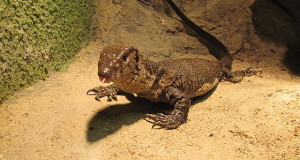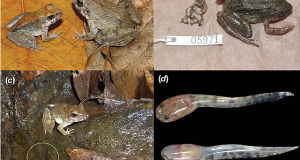 I remain awed by the learning abilities and complex behaviors evidenced by the Water and Lace Monitors I cared for at various zoos…spend time with any species and you’ll quickly see why. Despite being popular study subjects, monitors are constantly surprising us. For example, the current issue of The Journal of Herpetology (V44, N3, Sept 2010) documents an entirely new behavior for any monitor species – cooperative nest building and nest guarding in Rosenberg’s Monitor (Varanus rosenbergi).
I remain awed by the learning abilities and complex behaviors evidenced by the Water and Lace Monitors I cared for at various zoos…spend time with any species and you’ll quickly see why. Despite being popular study subjects, monitors are constantly surprising us. For example, the current issue of The Journal of Herpetology (V44, N3, Sept 2010) documents an entirely new behavior for any monitor species – cooperative nest building and nest guarding in Rosenberg’s Monitor (Varanus rosenbergi).
Nest Defense by both Sexes
A 16-year-long study of this species on Australia’s Kangaroo Island has revealed that females guard their nest sites for up to 3 weeks after egg deposition, a behavior that has not been documented for any other monitor (3 species, including the Komodo Dragon, may return to the nest site on occasion, but seem not to remain nearby). Amazingly, in 8 instances a male joined the female in protecting the eggs.
Other Rosenberg’s Monitors are the primary threat to eggs. Females guarding nests attacked male intruders twice their own weight, and repelled them in most cases. The vicious fights that ensued frequently left both combatants with deep wounds and broken ribs and limbs. In those cases where males were also on guard duty, they too joined in the frays, but females were clearly the more aggressive of the pairs.
Cooperative Nest Construction
 Female Rosenberg’s Monitors exclusively chose termite mounds as nest sites. In occupied mounds, the resident termites usually closed the nest entrance hole within 3-5 hours after egg deposition. If they did not, the female monitor finished the job.
Female Rosenberg’s Monitors exclusively chose termite mounds as nest sites. In occupied mounds, the resident termites usually closed the nest entrance hole within 3-5 hours after egg deposition. If they did not, the female monitor finished the job.
In another unexpected turn of events, male monitors assisted females in covering nests on 5 occasions.
Further Reading
Learning in Monitors and Other Lizards
Australian Government Report, Rosenberg’s Monitor – natural history, conservation plan, photos.
Water Monitor image referenced from wikipedia and originally posted by Rob and Stephanie Levy
Termite Mound in Australia image referenced from wikipedia and originally posted by Alchemist-hp
 That Reptile Blog – Reptile, Amphibian and Exotic Pet Care and Information
That Reptile Blog – Reptile, Amphibian and Exotic Pet Care and Information



